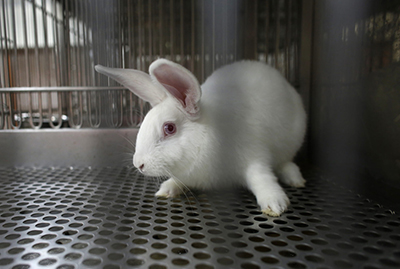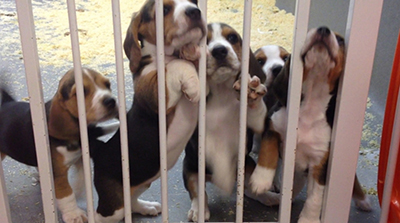22 million laboratory animals in the EU
Brussels, 11 February 2020 -
Around 22 million laboratory animals are used in research in the European Union each year.
This is what a report from the European Commission which analyzes the statistics of the European Member States for the years 2015-2017 reveals.
The report shows that the EU is far from ensuring the transition to research free from animal experiments.
Belgium is one of the main users of laboratory animals.
Our country is in the top 5 of the Member States that use the most painful tests on animals, and we are in fourth place in terms of the number of dogs used in the laboratory.
"There is no pride in this ranking," says Michel Vandenbosch, President of GAIA. We use even more dogs for experiments than countries like Spain. "
With 511,194 laboratory animals (gaia201102gaia201102of which 4,041 were reused in 2017), our country ranks 5th (excluding the United Kingdom) in the ranking of countries with the most animal experiments, after Germany, France, Spain and Italy. The Netherlands, Sweden, Ireland and Denmark complete the top 10.
The largest users of animals in the EU-28 are, in order, the United Kingdom with almost 2 million animals tested, Germany (+ 1.8 million) and France (almost 1.8 million).
Our country uses around 50,000 more animals than the Netherlands.
If we analyze the number of dogs tested, Belgium (1,856 of which 1,522 are reused) does worse than the Netherlands (less than 1,000 dogs).
In this area, Belgium is the 4th country to use the most dogs, if we no longer take the United Kingdom into account.
Intense pain
Our country is also in the top 5 of the Member States (including the United Kingdom) which have the largest number of laboratory animals subjected to acute pain (82,536), after France, Germany and the United Kingdom and Italy. With 16.5% of the total number of animals used in Belgium, Belgium ranks 6th after Poland (32.87% of the total number of animals used in this country), Ireland (29.25% ), Portugal (24.69%), Croatia (19.85%) and France (17.95%).
In the Netherlands (21st place), according to official statistics, 3.05% of laboratory animals suffer from acute pain: this is significantly less than in Belgium where almost one in five animals suffer severely.
22 million animals
In its report, the Commission examines both the implementation of the 2010 Animal Experimentation Directive "on the protection of animals used for scientific purposes" and the number of animals used.
Data provided by European Member States for the years 2015, 2016 and 2017 show that around 10 million animals are used in the European Union each year for scientific purposes.
More than a million experiments (11% of the total) cause a level of animal suffering described by researchers as "serious". However, the total number of animals involved in European research is much higher: an additional 12.6 million animals are raised and killed without ever being used in an experiment.
This brings the total to 22 million animals per year used in scientific research.
Belgium is a big user of laboratory animals
“An important objective of the directive on animal testing, which is now ten years old, is to replace laboratory animals by reducing, refining and replacing research methods (the 3 R rule, editor's note).
Animal-free experimental research is included in the directive as an objective.
Ten years later, it turns out that few if any of these goals have been achieved, "said GAIA President Michel Vandenbosch.
“With more than half a million experiments per year, Belgium is one of the main users of laboratory animals.
If we ignore the UK after Brexit, our country ranks fifth, just after Italy.
In addition, it is striking to note that dogs are still used in Belgium: our country is in fourth position.
We use more dogs for experiments than countries like Spain ”.
Often insufficient control
dden camera investigations, such as that of the Hamburg laboratory last year, where monkeys, dogs, cats and rabbits were abused and where gross breaches of the law were rife, show that everyday practices can be different from what the researchers claim.
Also in Belgium, GAIA has already highlighted the unacceptable practices (VUB, animalarium du Campus de Jette, 2016) of laboratories which have shown laxity and blurring of standards.
The European report shows that public control is often insufficient: in five Member States, public controls are systematically announced, while nine Member States do not meet the minimum requirement to control a third of research establishments each year.
Legislative review for transition to animal-free research
"We have heard for ten years that we are on the right track, thanks to a strict European directive and strict control by the government and scientists. The European Commission report now proves the opposite, ”says Michel Vandenbosch.
He insisted: "The current directive on the protection of laboratory animals is too well suited to the wishes of researchers and must be urgently revised in order to transition to research without animals".
The President of GAIA calls for an effective strategy and action plan, with concrete objectives, to effectively and systematically reduce the number of animals used in the experiments: “Much more must be done for research without resorting to sensitive animals.
Otherwise, in ten years, we will see once again that we have not moved a millimeter ”. |

